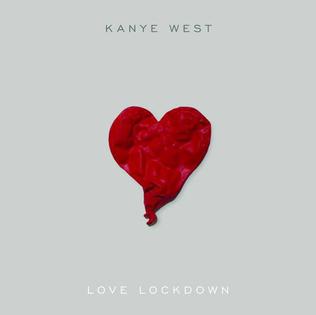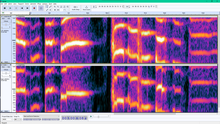
Deke Sharon is an American singer, arranger, composer, director, producer, author, coach, pioneer, and teacher of a cappella music, and is one of the leaders and promoters of the contemporary a cappella community. He has been referred to as "the father of contemporary a cappella" by some authors, and "the godfather of a cappella" by others.

Pitch correction is an electronic effects unit or audio software that changes the intonation of an audio signal so that all pitches will be notes from the equally tempered system. Pitch correction devices do this without affecting other aspects of its sound. Pitch correction first detects the pitch of an audio signal, then calculates the desired change and modifies the audio signal accordingly. The widest use of pitch corrector devices is in Western popular music on vocal lines.

Faheem Rashad Najm, better known by his stage name T-Pain, is an American singer, rapper, songwriter, and record producer. He is known for popularizing creative use of the Auto-Tune pitch correction effect, often used with extreme parameter settings to create electronic-styled vocal performances. Blending this with contemporary R&B and hip hop sensibilities, his music became characterized by this distinction, with other music industry artists such as Lil Wayne, Kanye West, Future, and Travis Scott utilizing it to a similar effect.

Believe is the twenty-second studio album by American singer and actress Cher, released on October 22, 1998, by WEA and Warner Bros. Records. Following the commercial disappointment of her previous studio album It's a Man's World (1995), her record company encouraged her to record a dance-oriented album, in order to move into a more mainstream sound. Cher started working on the album in the spring of 1998 with British producers Mark Taylor and Brian Rawling at the Dreamhouse Studios in London. The album was dedicated to her former husband Sonny Bono, who had died earlier that year.

"Believe" is a song by American singer Cher from her 22nd studio album, Believe (1998). It was released as the album's lead single on October 19, 1998, by Warner Bros. Records. After circulating for months, a demo written by Brian Higgins, Matthew Gray, Stuart McLennen and Timothy Powell, was submitted to Warner's chairman Rob Dickins, while he was scouting for songs to include on Cher's new album. Aside from the chorus, Dickins was not impressed by the track so he enlisted two more writers, Steve Torch and Paul Barry in order to complete it. Cher also later did some adjustments herself to the lyrics but did not get a songwriting credit. Recording took place at Dreamhouse Studio in West London, while production was handled by Mark Taylor and Brian Rawling.
Robotic voice effects became a recurring element in popular music starting in the second half of the twentieth century. Several methods of producing variations on this effect have arisen.
"Migrate" is a song by American singer and songwriter Mariah Carey from her eleventh studio album, E=MC² (2008). It was written and produced by Carey and Danja, with additional songwriting from the Clutch and the track's featured singer, T-Pain. An up-tempo hip hop and club track, the song's lyrical content is characterized by a revelatory club-hopping anecdote involving Carey's deliberation of going out for a night at the club, having a good time while enjoying a fun night out partying and grooving the night away.

Three Ringz is the third studio album by American singer T-Pain, It was released on November 11, 2008, by his record label Nappy Boy Entertainment. It was supported by three singles: "Can't Believe It" featuring Lil Wayne, "Chopped 'n' Skrewed" featuring Ludacris, and "Freeze" featuring Chris Brown.

"Love Lockdown" is a song by American rapper Kanye West from his fourth studio album, 808s & Heartbreak (2008). The song was produced by West, while co-produced by Jeff Bhasker. The producers co-wrote it with Esthero, Malik Yusef, and Starshell. West initially shared the song via his blog on September 10, 2008, before re-recording it after negative reactions. The song was later released for digital download on September 18, 2008 by Roc-A-Fella and Def Jam as the lead single from the album. An electropop song, its instrumentation relies on piano and Roland TR-808 drumbeats.

808s & Heartbreak is the fourth studio album by the American rapper and record producer Kanye West. It was released by Def Jam Recordings and Roc-A-Fella Records on November 24, 2008, having been recorded earlier that year in September and October at Glenwood Studios in Burbank, California and Avex Recording Studio in Honolulu, Hawaii. Dominating its production, West was assisted by fellow producers No I.D., Plain Pat, Jeff Bhasker, and Mr Hudson, while also utilizing guest vocalists for some tracks, including Kid Cudi, Young Jeezy, and Lil Wayne.

"Heartless" is a song by American rapper and record producer Kanye West from his fourth studio album, 808s & Heartbreak (2008). The song was written by West, No I.D., Kid Cudi and Malik Yusef, while being produced by the former two. It was passed on to West during recording sessions, after originally being intended for inclusion on Jay-Z's eleventh studio album, The Blueprint 3 (2009). Following the song's debut at the 2008 Democratic National Convention (DNC), West shared an unmastered version via his blog on October 15, 2008. The song was later serviced to US rhythmic contemporary radio stations as the second single from 808s & Heartbreak on October 28, through Roc-A-Fella and Def Jam. A pop ballad with influences of hip hop and R&B, it features synthesizers.

"Pop Champagne" is a song by American hip hop recording artist Ron Browz, originally released independently in June 2008. It is most famous for a remix with fellow American rappers Jim Jones and Juelz Santana that was officially released as a single on September 4, 2008 by Columbia and Universal Motown Records. The remixed version of the song serves as the lead single from Jones' fourth studio album Pray IV Reign (2009). "Pop Champagne" received mixed reviews from critics, but proved to be Jones' second most successful single to date, behind his 2006 hit "We Fly High".

"Lost" is a song by American hip hop recording artist Gorilla Zoe, released October 14, 2008 as the lead single from his second studio album Don't Feed Da Animals (2009). The song leaked in May 2008 entitled "Losin' My Mind", featuring a verse from fellow American rapper Lil Wayne. It is notable that, specifically with the Lil Wayne version, both songs use the auto-tune effect. "Lost" received positive reviews from critics praising Drumma Boy's electronic production and Zoe's sincere Auto-Tune delivery of introspective lyrics.

"Turnin Me On" is a song by American singer-songwriter Keri Hilson, from her debut album, In a Perfect World... The song features American rapper Lil Wayne who co-wrote the song alongside Hilson and Zachary Anson Wallace. Production credits are shared between Danja and Polow da Don, who also co-wrote the song. Following the minimal chart success of Hilson's worldwide lead single "Energy" in the United States, international markets received "Return the Favor", while "Turnin Me On" was released as the third single in the US.

"See You in My Nightmares" is a song by American rapper Kanye West, featuring fellow rapper Lil Wayne, from the former's fourth studio album, 808s & Heartbreak (2008). The song was written by West, No I.D., Jeff Bhasker and Lil Wayne. with production from the former two. It was scheduled to be released as the album's third single on March 10, 2009, ultimately being canceled in favor of "Amazing". A club number with an electronic beat, it relies on strings and synths. Lyrically, West and Lil Wayne discuss relationship troubles.

"Paranoid" is a song by American rapper Kanye West from his fourth studio album, 808s & Heartbreak (2008). The song features vocals from English musician Mr Hudson and background vocals from fellow American rapper Kid Cudi. West handled the production, with co-production from Jeff Bhasker and Plain Pat. The song was written by the producers alongside Kid Cudi and American rapper Consequence. It was serviced to top 40 radio stations in the United States on March 23, 2009, as the fourth and final single from the album. An upbeat new wave track, the song features electronic drum effects and pop synths. Its lyrical content is centered around West being pushed away by the mistrustful thinking of a woman that he is in love with.

"Amazing" is a song by American rapper and record producer Kanye West from his fourth studio album, 808s & Heartbreak (2008). The song features a guest appearance from Young Jeezy, and includes background vocals from Mr Hudson and Tony Williams. It was produced by West, while co-produced by Jeff Bhasker. The producers wrote the song alongside Malik Yusef, Consequence, Jeff Bhasker, and Young Jeezy. The song was serviced to US rhythmic contemporary and urban contemporary radio stations as the third single from the album on March 10, 2009, by Roc-A-Fella and Def Jam. A hip hop song with heavy pop influences, it features piano. Lyrically, West sings an attempt to capture part of his former bravado.

"D.O.A. " is a song written by American rapper Jay-Z and produced by No I.D. The song was released as a digital download on June 23, 2009, and as the first single from Jay-Z's 11th studio album, The Blueprint 3. The song made its world premiere on the New York radio station Hot 97 on June 5. Its lyrics address the overusage of Auto-Tune in the music industry. The song samples "In the Space" by French composer Janko Nilović. The bridge is inspired by Steam's "Na Na Hey Hey Kiss Him Goodbye" and interpolates lyrics from Kanye West's "Big Brother", and "You're Nobody " by The Notorious B.I.G. The song won Jay-Z his eighth Grammy Award, and his second for Best Rap Solo Performance. It peaked at No. 24 on Billboard Hot 100.

Revolver, is the fourth studio album by American singer T-Pain, released through Konvict Muzik, RCA Records and his own label Nappy Boy Entertainment on December 6, 2011. It is his first album released after the dissolution of his previous label, Jive Records. Recording sessions for the album have taken place from 2009 to 2011. T-Pain stated that the two R's in the word, RevolveЯ have been capitalized so that in the middle, it says "evolve", indicating that T-Pain has evolved as an artist, and as a person in the period from Thr33 Ringz up till RevolveЯ. He later stated that the R's were put to show how people can be deceived, and understand things incorrectly without looking at the inside of things and this is the scheme of the album.

"Sing It" is a song by American recording artist Rebecca Black. It was released on the iTunes Store under the label RB Records, as Black's fourth single on May 8, 2012. "Sing It" received mixed to positive reviews from music critics, surprising some due to the song not being modified with the pitch correcting software Auto-Tune that was used in Black's previous singles. The accompanying music video premiered the day before.





















